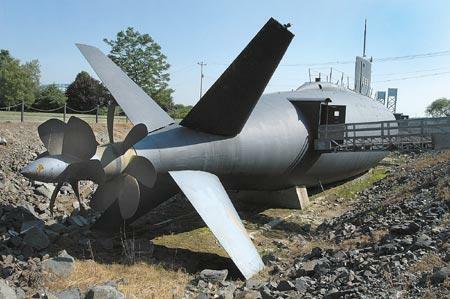Submarine Launched 50 Years Ago From Portsmouth Shipyard
By Nancy Cicco
The Portsmouth Herald, Friday, August 1, 2003

PORTSMOUTH – She was the forerunner of the modern-day submarine, and present-day undersea warfare owes much to her design.
Fifty years ago today an uncommissioned Albacore was launched from Portsmouth Naval Shipyard following a ceremony that both paid homage to the men lost on her namesake and heralded the future of these stealthy vessels.
On Aug. 16, men who once served on the USS Albacore will get together at Albacore Park off Market Street to commemorate the submarine’s birthday and her role in history.
“Many former crew members from all over the country are coming back,” said Albacore Park board member Russell Van Billiard this week. “It appears there may be over 100.”
The Albacore was built at the Portsmouth Naval Shipyard between 1952 and 1953 for $5.3 million, according to Van Billiard, who worked at the shipyard as a submarine design engineer for 35 years.
Originally measuring 200 feet long and 25 feet wide, the submarine reached a standard displacement of 1,200 tons and carried 40 crew members.
She didn’t become the USS Albacore until December 1953, when she was commissioned by the U.S. Navy. Once she joined the Navy fleet, she served until 1972, when she was retired to the Philadelphia Naval Shipyard.
The first in a class of research submarines, she never carried a weapon or served in war. But in her day, the USS Albacore was the world’s fastest submarine and a standard-bearer for all submarines to follow.
“It wasn’t built to kill people. It was primarily built to test out a new hull shape that would go faster under the water,” Van Billiard said. Once that streamlined hull design was married with submarines with nuclear capabilities, the modern-day vessel was born.
“All of our subs since have been built that way, and most subs in foreign navies have been built that way, too,” Van Billiard said.
Championing the new hull design was Navy Vice Adm. Charles “Swede” Momsen, who in 1939 was in charge of the rescue of 33 sailors trapped in the USS Squalus, another submarine built at the Portsmouth Naval Shipyard. When the Squalus sank off the Portsmouth coast during a test run, 29 crew members lost their lives. But survivors were saved by a rescue chamber invented by Momsen that attaches to a submarine’s hatch in order to free trapped crew members and lift them to the water’s surface.
During the USS Albacore’s tour of duty, she was used to test control systems, dive brakes, sonar equipment and escape mechanisms, according to information provided by Van Billiard.
The submarine was named after the original USS Albacore (SS 218). That submarine, built in Groton, Conn., was pressed into service at Pearl Harbor in 1942. She sunk many enemy vessels during World War II, but on her 11th war patrol, on Nov. 7, 1944, she struck a mine while in enemy waters off the coast of Japan.
In honor of the men lost in that event, the widow of J.E. Jowers, one of the crew members, christened the second USS Albacore by breaking a bottle on her bow during the launch ceremony. The new vessel, commanded by Lt. Cmdr. Kenneth C. Gummerson, would have 11 other commanders before she was retired, according to information provided by Van Billiard.
Many of the Albacore’s crew members went on to serve as commanders of nuclear submarines, according to Charlie Perry, an 86-year-old former shipyard worker who helped build the submarine.
Perry, of Kittery, Maine, was one of a handful of people who was inside the vessel when she was launched in 1953.
“We had an idea that it was going to be very fast and very maneuverable,” said Perry. “It was truly a plum.”
Perry was a first-level supervisor in the shipyard’s pipe shop while the USS Albacore was being built.
The submarine’s design received an award from the National Mechanical Association, according to Perry.
“I stand in awe of the people who designed it and the people who operated it,” he said.